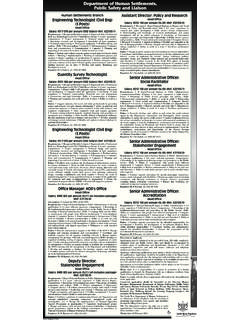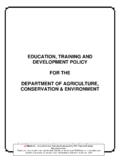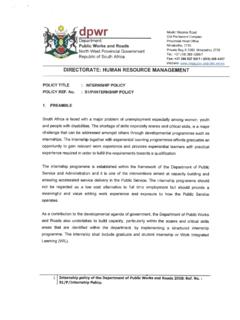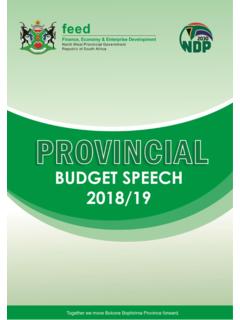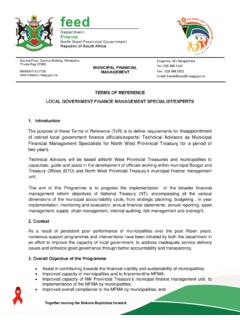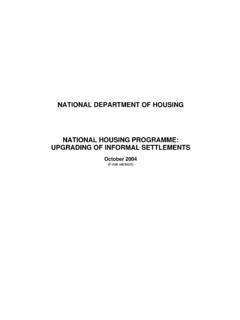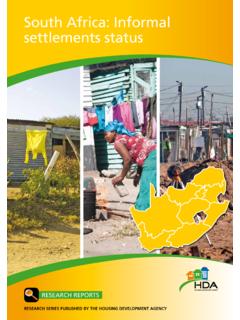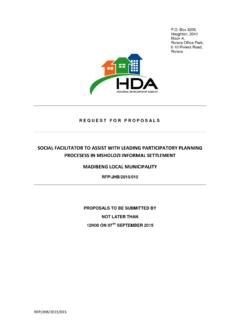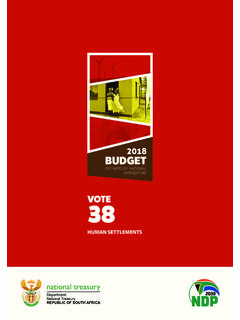Transcription of HOUSING PROJECT PROCESS GUIDE - North West
1 HOUSING PROJECT PROCESS GUIDEA PROCESS GUIDE for the following National HOUSING Programmes: Integrated Residential Development ProgrammeThe upgrading of informal Settlement ProgrammeThe Rural Subsidy: Communal Land Rights Programme. September 2009 The greatest possible care has been taken in compiling this GUIDE , and in ensuring that it is an accurate interpretation of the HOUSING policy. It may be possible, however, that there are differences in how the HOUSING policy is applied from province to province, and consequently differences in approach to those noted here may not be relevant for some provinces. The National Department of Human Settlements can not take any responsibility for how the policy is applied from province to province. It is recommended that provincial differences in approach be determined before using this GUIDE to embark on a PROJECT . Users of this GUIDE will accordingly use it at their own risk and The National Department of HOUSING will not be liable for any damages whatsoever that may be suffered by any user of this GUIDE arising out of any direct or indirect reliance placed on the content of this GUIDE .
2 HOUSING PROJECT PROCESS GuideCLARA Communal Land Rights Act, Act 11 of 2004 DFA Development Facilitation Act, Act 67 of 1995 EIA Environmental Impact AssessmentEIAP Environmental Impact Assessment Practitioner EMP Environmental Management PlanESTA Extension of Security of Tenure Act, Act 62 of 1997GP General Plan IDP Integrated Development PlanIPILRA Interim Protection of informal Land Rights Act, Act 31 of 1991 IRDP Integrated Residential Development ProgrammeLEFTEA Less Formal Township Establishment Act, Act 113 of 1996 LDO Land Development ObjectivesMEC Member of the Executive Committee NDoHS National Department of Human Settlements NHBRC National Home Builders Registration CouncilPHD Provincial HOUSING DepartmentROD Record of DecisionRSDF Regional Spatial Development Framework SDF Spatial Development FrameworkABBREVIATIONSH ousing PROJECT PROCESS Guide1 PART ONEI ntroduction 2 Selection of HOUSING Programme 3 The HOUSING Code 4 National HOUSING Policy Context 5 The Three Programmes 6 The Integrated Residential Development Programme 6 The upgrading of informal Settlements Programme 8 The Rural HOUSING Subsidy: Communal Land Rights 10 PART TWOFlow Charts 13 Integrated Residential Development Programme 14 Rural HOUSING Subsidy.
3 informal Land Rights 16 Notes on Flow Charts 18 PROJECT Schedule 34 TABLE OF CONTENTS2 The Department of Human Settlements and the National Business Initiative produced a HOUSING PROCESS GUIDE in 1997. During the 12 years since then, tremendous progress has been made with delivery, and the National HOUSING Programme and HOUSING Code has also evolved based on experience and changing HOUSING PROJECT PROCESS GUIDE has been developed for the three specific programmes which are mostly utilized for subsidized HOUSING development, namely The Integrated Residential Development Programme The upgrading of informal Settlements Programme Rural HOUSING Subsidies: Communal Land Rights ProgrammeThe previous GUIDE emphasised the contractual relationships between parties in addition to the processes to be followed. At that stage there was also a focus on social compacts and private developer driven HOUSING developments.
4 The new HOUSING Code is comprehensive and includes detailed examples of contracts and contractual relationships, as well as many specific guidelines to assist the developer of any major change since 1997 is that the public sector organs have assumed the role of developer of subsidy HOUSING projects, although the private sector is still involved in the implementation of the PROJECT . The Government has also created a HOUSING Development Agency to inter alia act as developer of HOUSING projects or which may assume a developer role. The terminology used is that Developer means the Government department at provincial or local level that is responsible for implementing the PROJECT . Contractor means any private company or individual contracted by government to fulfil a function on the PROJECT whether it is managing the PROJECT , providing a professional service (deliver HOUSING goods and/or services) or doing HOUSING PROJECT PROCESS GUIDE is not intended to replace or repeat information and guidelines in the HOUSING Code, but is specifically intended to assist managers at all levels to understand the processes that projects must go through to achieve the required end product, the relationships between the processes, the required time frames and the responsibilities of the various role-players and professionals the past 15 years the Department has found that in most projects where serious delays or problems occurred, it was due to crucial steps in the development PROCESS being bypassed.
5 As an example, this resulted in situations where houses were constructed which could not be transferred to occupants, or stands were serviced without any links to the municipal bulk GUIDE is also not intended to detail the processes that Professionals follow in their work, be it town planning, design or conveyancing, but to highlight the overall processes that must be completed at specific stages of a GUIDE is also not a comprehensive PROJECT management GUIDE , but is a tool for the successful PROJECT management of HOUSING projects, and includes a summary checklist which can be used to monitor progress on a PROJECT , and can also be used as the basis on which progress payments are terminology used in different provinces and in the Development Facilitation Act varies for the various processes to establish development rights and ultimately enable the developer to transfer ownership to or protect the rights of individual beneficiaries.
6 These processes include, but are not limited to, subdivision, rezoning, establishment of Land Development Areas, township establishment and division of land. This GUIDE uses the generic terms township establishment and rezoning to describe these PROJECT PROCESS Guide3 The HOUSING Code describes the correct application of the various subsidy programmes. The diagram below contextualizes the three programmes covered in this GUIDE with notes on the selection of the correct subsidy programme. It highlights the differences between the three programmes in this GUIDE to ensure that the correct context of the chosen programmes is fully understood. Many of the processes in this document can also be applied to other HOUSING Programmes, although the product may be completely different. The basic building blocks and the statutory requirements of a HOUSING PROJECT remain similar.
7 Users of this GUIDE can select applicable components of the PROJECT schedules and checklists and adapt it for their specific of the problems experienced in the closing-out phase of projects can be related to an inappropriate choice of programme. Sometimes this is done due to a perception that one programme has fewer statutory requirements than another, or can be implemented faster. Again, in most cases the basic building blocks of the projects remain the same and the correct programme is usually the one that can be fully completed in the shortest time frame. SELECTION OF SUBSIDy PROGRAMMES Intervention CategoryHousing ProgrammeDescriptionFinancialIndividual HOUSING SubsidiesThese programmes provide subsidies to individuals to purchase completed or existing properties, grant funding to Municipalities and/or Provinces to deliver services or facilities for professional services to facilitate planning and Discount Benefit SchemeSocial and Economic FacilitiesAccreditation of MunicipalitiesOperational Capital BudgetHousing Chapters of IDP sRectification of Pre-1994 HOUSING StockIncremental HOUSING ProgrammeIntegrated Residential Development ProgrammeThe programme facilitates the structured upgrading of informal settlements.
8 It applies to in situ upgrading of informal settlements as well as where communities are to be relocated for a variety of reasons. The programme entails extensive community consultation and participation. Emergency basic services provision, permanent services provision and security of HOUSING ProcessInformal Settlement upgrading ProgrammeConsolidation SubsidiesEmergency HOUSING AssistanceSocial and Rental HOUSING ProgrammeInstitutional SubsidiesSocial HousingCommunity Residential UnitsRural HOUSING ProgrammeRural Subsidy: informal Land RightsThe Rural programme is used to extend the benefits of the HOUSING Subsidy Scheme to those individuals living in areas referred to as rural areas where they enjoy functional security of tenure as opposed to legal security of tenure. Only individuals whose informal land rights are uncontested and who comply with the qualification criteria will be granted such Rural National HOUSING Code 2009 sets the underlying policy principles, guidelines and norms and standards which apply to Government s various HOUSING assistance programmes introduced since 1994 and purpose of this GUIDE is to provide an easy-to-understand overview of the various HOUSING subsidy instruments available to assist low income households to access adequate detailed description of the policy principles, guidelines, qualification criteria and norms and standards are available in the National HOUSING HOUSING CODEH ousing PROJECT PROCESS Guide5 The South African Constitution.
9 1996 enshrines the right of everyone to have access to adequate HOUSING and makes it encumbent upon the State to take reasonable legislative and other measures within its available resources to achieve the progressive realisation of this response to this Constitutional imperative, Government has in terms of the HOUSING Act, 1997 (Act No 107 of 1997) introduced a variety of programmes which provide poor households access to HOUSING opportunities. The policy principles set out in the White Paper on HOUSING aim to provide poor households with houses as well as basic services such as potable water and sanitation on an equitable limited resources available from the fiscus however necessitate the prioritisation of the most vulnerable groups as well as the provision of HOUSING , security and comfort to all over time. Ten years after the introduction of the HOUSING programme in 1994, a comprehensive review was undertaken of the outcomes of the programme and the changes in the socio-economic context in the country.
10 This lead to the approval of the Comprehensive Plan for the Creation of Sustainable Human Settlement commonly referred to as Breaking New Ground or BNG , by Cabinet in September retaining the basic principles of the HOUSING White Paper, the Comprehensive Plan shifts the focus to improving the quality of HOUSING and HOUSING environments by integrating communities and settlements through a holistic development orientation. It also sets new minimum standards for HOUSING products improving privacy and sustainability by providing for the development of a range of social and economic facilities in human settlements. The Comprehensive Plan also focuses on the upgrading of informal settlements in order to meet the Government s commitment towards achieving the Millennium Goal of the United Nations to improve the lives of 100 million slum dwellers order to support the implementation of the Comprehensive Plan, HOUSING departments in all spheres of Government, as well as HOUSING Support Institutions have been extensively , the National HOUSING Code of the year 2000 has been substantially revised.
